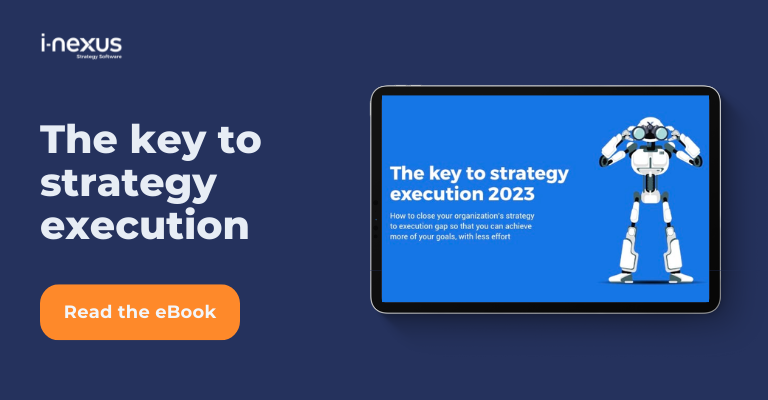Remember the popular childhood game where a line of children would whisper a message to one another? When the message reaches the final player, they announce it to the entire group of players and low and behold; it is usually a distorted garble or a pale imitation of the original message. Believe it or not, there is a considerable business lesson to learn from this when it comes to your strategic objectives and operational reality.
Written by: Steve Kerr, Campaign Marketing Manager.
This lesson is already being applied by the world's leading organisations who practice Hoshin Kanri (also called Policy Deployment) - a method for ensuring that the strategic goals of a company drive progress and action at every level within the company. So, read on for tips that you can apply in an organisation to safeguard your strategy execution.
Strategic planning status quo
The usual strategy planning process involved the CEO and his direct reports picking a few issues critical to long-term success — issues such as dramatic efficiency savings, an improvement in quality or a step change in customer satisfaction.
They then bust out the Sharpies and Post-it Notes (other sticky notes and markers are available) and generate initiatives and activities to deploy to address these issues. However, if the company has any scale, they rarely succeed. Generally, due to communication issues where the CXO whisper (or delegate) objectives, goals and initiatives get lost through the grapevine as each level of management interprets them.
By the time they reach the front line of the organisation, where the workforce is absorbed in the day to day, they struggle to address and deliver these Hoshin Kanri objectives even if they are built into local work plans.When we observe world-class strategy execution systems such as Danaher and Toyota, who have developed ways to translate high-level Hoshin Kanri plans into remarkable results which have enabled them to separate from the pack, there are 5 ways you can ensure your strategic objectives don’t get muddled.
1) Connect strategy to operations
The gap between strategy and operations can be a chasm.
It all begins with an exciting proclamation of intent – ‘our strategy is going to shake up the industry, and our company will be one of the top optical lens providers in the United Kingdom!’, or something of that ilk.
From there flows a set of goals, objectives and KPIs, and then the company gets to work - but something is missing. Those objectives, goals and KPIs get relegated to the top drawer of desk side cabinets, not to be looked at until periodic performance reviews.
This spells disaster from the offset for your new strategy because there is no connection between the day to day operations of your business and the strategy that has been defined.
Top performing companies have found a way to bridge the gap. The strategy needs to be cascaded right down to a project level and tracked in real time to ensure that people are working on the right things—in other words, actions that drive the strategy. By partnering with the business units to provide excellent execution, you’ll meet far more of your goals.
2) Keep an open mind
Every strategy is based on a set of assumptions. And without the right checks, balances and validations, these assumptions can bring dire consequences:
“Too often, shareholders, employees and other major stakeholders unnecessarily invest time, money and energy in supporting an organisation’s vision and strategic plan, not recognising that the vision and plan were doomed to fail from the day they were conceived.” Mark Hollingworth
These assumptions do have a place at the beginning, but they must be acknowledged for their inherent risk.
For example, it is acceptable to assume how your customers’ purchasing habits may change given your current understanding of the macro environmental forces. Equally, you’ll have a sound knowledge of the learning and development needs of your workforce if you’ve assessed them and appreciate your micro influencers. But without challenging these assumptions and succumb to hubris, the path of continuous improvement will never be walked.
It’s all too common for managers to stick doggedly to a plan when even the evidence says that it’s not working. This resistance to change must be dealt with correctly. For example, once you’ve ruled out poor execution, you need to question underlying assumptions and, when appropriate, correct the course.
Please don’t assume you got it right at the beginning; keep every option open when it comes to improving your performance.
3) Be proactive
For optimum performance, you really need dashboards and reports in place that consolidate data across groups, set common KPIs, and establish leading indicators to monitor your progress, continuously.
How those dashboards come out really depends on the type of resource you have. That could be a simple Excel spreadsheet or a third party system. We are of the belief that the size and complexity of your organisation is a great indicator of what suits best.
For example, if you are a startup where resources are limited, Excel will suffice.
However, should your organisation be of an enterprise scale, where you have hundreds, if not thousands of team members all pulling towards your True North, working on different initiatives with multiple systems and data sets, an all-in-one solution is clearly needed.
With the right system, measuring, acting and improving on each activity will ensure you proactively manage your strategy deployment, rather than looking in the rear-view mirror at poor results and missed opportunities. If your groups speak the same language and share a common data repository, then you can look forward not back, and move with agility and confidence.
4) Pay attention
Your focus is critical. You should always be assessing your portfolio of projects, not only to measure progress but also to question how important each one will be to driving strategy.
This necessitates the courage (and data) to put to rest projects that are failing or not aligned to strategy, allowing you to concentrate on what’s important.
The purpose of an agile approach is that you can optimise, refine, and if necessary, re-address your initiatives to ensure that they’re still fulfilling the role they have been assigned in reaching the maximum utilisation of resources and value for your customers.
By paying attention to your portfolio of projects, you’ll be able to spot and act on early warning signs. And remember, there are a plethora of reasons that things can go awry:
- A change-resistant culture
- Unsupportive project sponsors
- An ambiguous project purpose
- Disengaged, misaligned team members
- No confidence in the project manager
- Poor connection to breakthrough and annual goals
5) Automate
Too many companies rely on clunky spreadsheets and a lot of elbow grease to manage their strategy deployment. However, what kind of impact can the introduction of a software platform have on your results?
How about doubling the percentage of strategic goals achieved and reducing project cycle time by 25%?
Even those organisations just beginning to mature their strategy deployment efforts see compelling ROI in the first year when they take the heavy lifting out of strategy deployment by automating with i-nexus software and support.
Want to learn more about cascading strategic objectives?
Test drive the power of the world’s leading strategy execution software.
We help enterprises move away from traditional approaches to strategy execution that involve spreadsheets, reports and slides.
Seeking more thought-provoking content?
We have a wealth of resources freely available to digest, all designed to help you achieve your strategic goals. We've hand-picked the below to set you on the right track:
- Strategic transformation and the Fourth Industrial Revolution: Discover how focusing on strategy execution can help your business to harness disruptive technologies and seize competitive advantage during the Fourth Industrial Revolution.
- The Key to Strategy Execution: Uncover the benefits of excellent Strategy Execution, the organizations who have succeeded, and how your business can follow suit.
About the author
Steve Kerr is i-nexus' Marketing Campaign Manager. He's passionate about bringing i-nexus' value to life through creative, thought-provoking, strategically minded content and communications. Working across broadcast, the arts, housing and software, his strategic mindset has brought fantastic results for every organisation he has worked with.
If you'd like to talk more about all things strategy execution, reach out to Steve on steve.kerr@i-nexus.com or connect with Steve on LinkedIn for more strategic insights.



